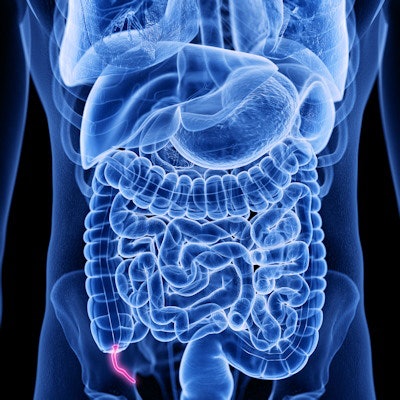
Clinical decision support could boost the appropriate use of CT for diagnosing appendicitis in children presenting at the emergency department (ED), according to research published February 9 in JAMA Network Open.
A team led by Dr. Anupam Kharbanda of Children's Minnesota in Minneapolis found that although decision support didn't necessarily reduce the overall use of CT for diagnosing pediatric appendicitis across the entire study population, at one health system it did reduce the use of the modality in those children at low or moderate risk of the condition.
"Although [our study] did not show an overall reduction in imaging, [it] revealed more appropriate use of diagnostic imaging," the group wrote.
Although appendicitis is the most common pediatric surgical emergency, it can be difficult to distinguish it from other causes of acute abdominal pain, Kharbanda and colleagues noted. The pressure to improve emergency department efficiency has led to an increase in the use of CT and ultrasound in patients with suspected appendicitis, but both have their drawbacks: CT exposes children to radiation and ultrasound may produce unclear results.
Kharbanda and colleagues sought to investigate the effect of using AppyCDS, a clinical decision-support tool linked to an electronic health record system they developed, on diagnostic imaging, healthcare costs, and safety outcomes (i.e., perforations, negative appendectomies, and missed appendicitis) in children with suspected appendicitis.
The study included data from 5,940 patients seen in 17 community-based general emergency departments in California, Minnesota, and Wisconsin between October 2016 and July 2019. Mean patient age was 11.9 years; all presented in the ED with right-side or diffuse abdominal pain for five days or less.
AppyCDS helped estimate appendicitis risk using the pediatric appendicitis risk calculator, or pARC; it then recommended steps for next care based on pARC scores. A pARC score with a higher percentage indicates a greater likelihood of appendicitis. For the study, a pARC score of less than or equal to 15% indicated a lower risk of appendicitis than a score of 16% to 50%.
The EDs were randomized to an AppyCDS intervention group or a usual care group, with "usual care" meaning pARC scores and recommended next steps were not displayed on the workstation. The researchers then measured changes in imaging use in the same time periods, both at facilities using AppyCDS and those that didn't.
Across the 17 emergency departments included in the study, Kharbanda's team did not find that AppyCDS led to an overall reduction in the use of CT or ultrasound for assessing pediatric appendicitis. But when the authors examined data from each ED further, they found that one health system (Kaiser Permanente Northern California) had statistically significant results indicating that AppyCDS reduced the use of all types of imaging in patients with a pARC score of 15% or less, as well as CT use in those with a pARC score of 16% to 50%.
Neither safety outcomes nor costs differed significantly between the AppyCDS cohort and the usual care group across all of the EDs.
The study suggests that using an electronic health record-linked appendicitis clinical decision-support tool in community-based EDs has the potential to reduce unnecessary imaging, but more research is needed, particularly regarding ultrasound, Kharbanda and colleagues concluded.
"To achieve sustained reductions in diagnostic imaging, further studies should evaluate targeted approaches to ultrasound based on appendicitis risk," they wrote.



















